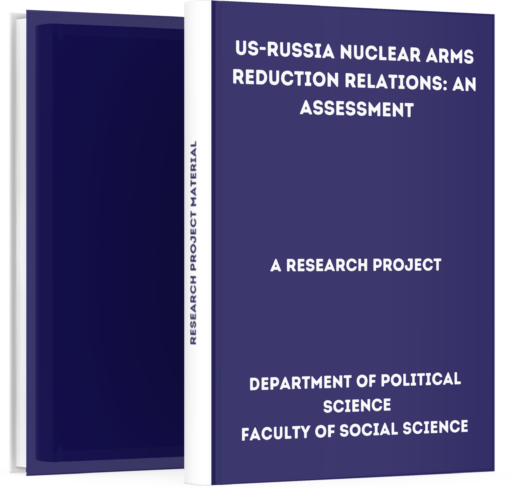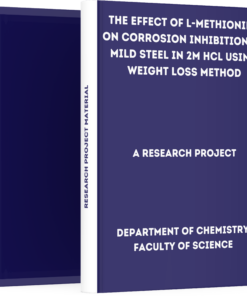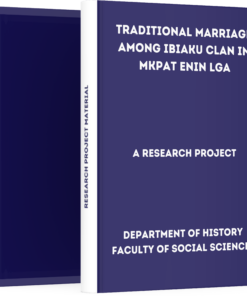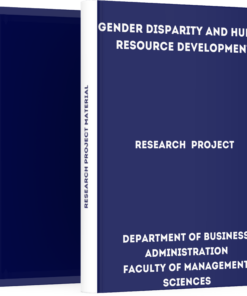Us-Russia Nuclear Arms Reduction Relations: An Assessment
₦3,000.00
If you are interested in getting this project material “Us-Russia Nuclear Arms Reduction Relations: An Assessment”, click on the DOWNLOAD BUTTON to make payment and the file will be delivered to your email immediately after confirmation.
Description
– Us-Russia Nuclear Arms Reduction Relations: An Assessment –
Download Us-Russia Nuclear Arms Reduction Relations: An Assessment. Students who are writing their projects can get this material to aid their research work.
Abstract
During the Cold War, the United States and Soviet Union both deployed thousands of strategic and non-strategic nuclear weapons that were to be used in support of troops in the field during a conflict.
It was in a bit to avoid any nuclear confrontation by both sides that prompted the leaders of both countries to enter into several treaties that would reduce the nuclear warhead in both countries nuclear arsenal.
But not much success was made as there was still lack of trust, especially the Bush’s administration which later indicated its interest to pull out of the Anti Ballistic Missile treaty (ABM) or Moscow treaty. With this the Bush administration made the
U.S option for nuclear reduction open. In the post Cold War, relations between both countries was further strained following President Bush’s intention in 2007 to deploy missile defence system in Eastern Europe by placing missile interceptors in Checz republic and a radar station in Poland while using a possible nuclear threat from Iran as leverage.
The prospect of a new American global military strategic control. This issue aroused greater Russian protest. Russia sees this single move as a direct danger to Russian security, potentially undermining its ability to deter attack from the West as well as America’s impending military incursion into Russian territorial space.
It was upon the ascension into office as President that the Obama administration scrapped the $2.5 billion missile defence system and its reason that the administration found that technological advances and a shifting threat from nuclear proliferant nations made the scrapping inevitable.
Introduction
1.1 Background of the Study
The U.S-Russia relations were at the low point of the cycle of great expectations and profound disappointment since the break-up of the Soviet Union in 1991.
The grand vision of the strategic partnership that Presidents George W. Bush and Vladimir Putin articulated at the Moscow/St.
Petersburg summit of May 2002 ran afoul fundamental differences over Iraq, the terrorist threat (especially in Chechnya), energy security, coloured revolutions in the former Soviet space, and Russian domestic developments.
Putin’s address to the international security conference in Munich in February 2007 castigating alleged U.S effort to build a unipolar world present a familiar litany of Russia grievances of the United States’ refusal to discuss arms controls and the militarization of space,
U.S missile defense sites in Europe, NATO expansion, discrimination against Russia companies seeking to invest abroad, the focus of the Organization for Security and Co-operation in Europe (OSCE), underscored how far relations had sunk .
The U.S-Russia post cold war relations in the first decade after the break-up of the Soviet Union was much the same. President Boris Yeltsin extended a “hand of friendship to the people of America,” (Washington Post, June 18, 1992) and President Bill Clinton talked of a strategic alliance with Russian reform” .
Americans had great expectations for rapid market and democratic reform in Russia along American lines because they thought, it was a natural destination with the “end of history;” and Russians expected to be welcomed into the West with open arms, as they were in gratitude for their central role in “ending history” by bringing down communism as a global movement.
All these hopes were dashed by the Russian financial crisis of 1998 and the deep discord over NATO’s military campaign against Yugoslavia in 1999.
How to Download this Project Material
First, note that we are one of the best and most reliable online platforms because we don’t retain any of your personal information or data as regards making payments online.
PRICE: ₦3,500 ₦3,000 (Three Thousand Naira Only)
Make a bank deposit or mobile transfer of ₦2,000 only to the account given below;
Bank Name: UBA Account Number: 1022564031 Account Name: TMLT PRO SERVICES
After making the payment, CLICK HERE to send the following on WhatsApp;
- Depositor’s Name or Screenshot of Payment
- Name of the Past Question
- Active Email Address
or Call Us On +2348082284439 Once your details have been received and your payment confirmed by us, you will receive the past question in your email or WhatsApp within 5 Minutes.
Guarantee of Getting the Material
We understand that due to the high rate of fraud, many people are afraid of making purchases online but be rest assured that PastExamQuestions will deliver your material after payment.
Once your details have been received and your payment confirmed by us, you will receive the past question in your email or WhatsApp.
Give us Feedback
Have we been able to satisfy you? How well do you think the material will be helpful after having gone through it? Does the price worth the material?
Let’s hear from you! We recommend that our customers give feedback at the end of every transaction to enable us to serve better. You can do this by clicking the review button on this page.
Where is the review button? >> Just scroll up to where you see reviews





Reviews
There are no reviews yet.